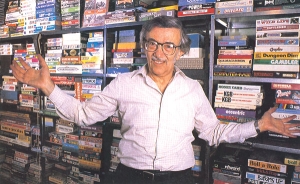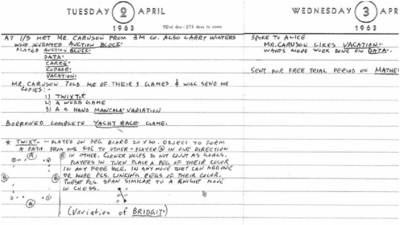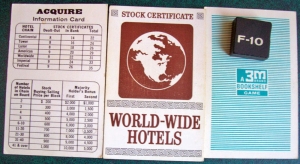This manuscript also shows the struggle Sid had with trying to write rules for a two-player game. When he changed the name, he also crossed out his attempt to construct rules for such a game and at the top of the manuscript he changed it to read, “From 3-6 players.” DECISION, and subsequently VACATION, were ideas that were too difficult to corral to just two players. To this day, four players are optimum for a balanced game.
On Tuesday March 26, 1963 Sid was contacted by his agent, Alice at I/S, concerning the quest by the 3M Company to test market three new games in the Midwestern United States and that they were looking for more games. The 3M Company, Minnesota Mining, & Manufacturing, had recently hired William Caruson to create a board game division within the company.
The 3M Company had recognized that due to technological advances in the work place, combined with newly evolving labor laws, the average American had more leisure time. They also recognized that most board games were directed towards children and not adults. So, the 3M brain trust decided that they would try to fill the new void in the lifestyle of the average American family by creating a series of adult “bookshelf” games that were directed towards increased social interaction. The company was looking for games that could fit into a box that was the same size as a normal book so that the games would fit on the bookshelf.
By the next day, Sid was busy creating a box design for his game of VACATION. Three days later on March 29, 1963, Sid took the game of CARRE and VACATION to I/S Unlimited. By April 2nd he was already meeting with Bill Caruson at the offices of I/S Unlimited. The meeting also included Larry Winters, who had created a game called “AUCTION BLOCK” that 3M also had an interest in.
During that meeting, Sid gave 3M the game manuscripts for DATA, CARRE, COPADE, and VACATION. By the next day, Caruson provided feedback. He liked VACATION, but thought DATA needed some work. By April 22nd 3M had rejected the idea of CARRE, but two days later on the 24th, Sid was notified that they liked the idea of VACATION.
3M wanted approval to test market VACATION that upcoming Christmas season. Yet even though the 3M Company was asking for approval, they still were not willing to commit to the game. They stated that they would make a decision by mid-May.
On May 17, 1963, Sid was notified that 3M had sent money to hold the rights to the game of VACATION for a longer period of time. On June 11, 1963, Sid was contacted by Alice. She told him that Caruson had called and said that they “want to make changes to VACATION to cut costs and said they would send a letter with explanations.”
NOTE: I could never find this letter in any of the 1963 correspondence. It is never mentioned in Sid’s Diary or in the folder of 3M Correspondence for 1963. Also, the correspondence between I/S Unlimited and Sid is missing for the years 1963 and 1964. This became a reoccurring problem during my research for all changes that were made by 3M during this period.
Many things may have been discussed through phone conversations, and therefore, there is no history. I did find a letter in the 1964 3M correspondence that addressed changes. So I would assume that, other than the name and the deviation from his original drawings for board and tiles, the discussion of major changes occurred after the release of the test market games.
~ Lloyd Solon
After that June 11th Diary entry, Sid did not mention the game again until September 9, 1963. On that day he wrote, “3M wants to change VACATION to ACQUIRE.” I can only assume, without access to further information, that the 3M Company already had a working idea for a game called ACQUIRE and then stumbled across the idea that Sid sent them.
I make this assumption because the artwork for the eventual mass production box for the game of ACQUIRE is dated 1962 and they didn’t get Sid’s idea until March of 1963. 3M had probably developed the artwork the year before and then just tailored it to Sid’s idea. The first test market games of ACQUIRE were dated with a copyright of 1963, but when it came time to mass produce the game in 1964, 3M chose to use the 1962 copyright of the artwork on the outside of the box and the 1963 copyright of Sid’s idea on the inside box with the rules.
3M had mentioned that they wanted to make changes to VACATION to cut costs, so by making the name change to fit some previously constructed artwork made sense to save money. Yet, by comparing Sid’s original manuscript to the test market games that were produced, we can see some of the other changes made by 3M.
Sid had envisioned a board with squares that designated different cities around the globe and were clustered into continents. 3M made the board into a picture of a world map and the squares only had the squares designation. Sid had also envisioned tiles that had various forms of hotels printed on them, but the 3M Company made the tiles out of wood with the squares' designations printed on them.
The chipboard method of tiles that was designed by Sid would probably have been cheaper to produce after the artwork expense, and Sid actually suggested that method in a later letter, but I believe 3M used the wood tiles because they were the same wood tiles that the company was using in other bookshelf games such as PHLOUNDER and QUINTO. Since 3M could use the same type of wood tile in all three games, they could reduce their costs overall.
3M changed the names of Wilton and Sharedon to Tower and Imperial. They also decided to print all 200 of the stock cards on white card stock instead of printing 140 on white card stock and the sixty to be shuffled and dealt on yellow card stock. This move also saved them money in production.
By September 20, 1963, 11 days after the notification of the name change, Alice of I/S Unlimited was already writing a counter offer to a contract offered by 3M for the game of ACQUIRE. 3M had constructed a contract offer that was heavily skewed in their favor. The first issue that was addressed was the fact that 3M had offered a limit of royalty payments in the amount of $25,000. Sid’s agents would accept no less compensation than royalties for the life of the game. Considering the continuing life of the game of ACQUIRE, this was a very wise move.
3M also wanted Sid to “assign all interest” in the game of ACQUIRE to them. His agents wanted them to only have the right to “make, use, and/or sell” the game. His agents also wanted the rights to the game of ACQUIRE to come back to the inventor when the company decided to discontinue the “production, marketing, and promotion” of this game. It may have been beneficial to ask for the right to take the game back from the company if the inventor was dissatisfied with the company's efforts to produce, market, and /or sell the game since the contract and rights are stated to continue if 3M chose to sell its interest to another company.








